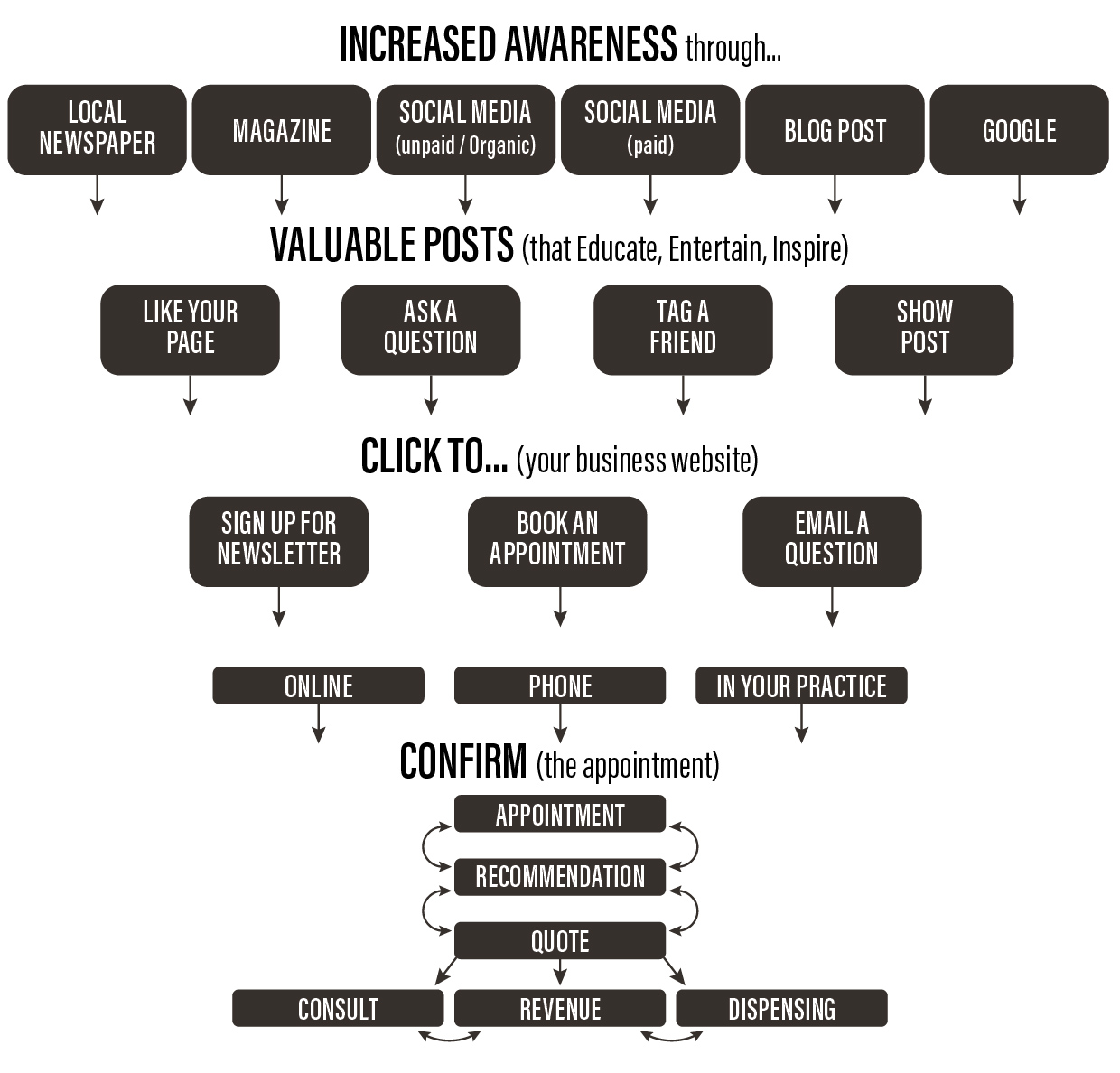
Picture your practice thriving. You feel powerful, valuable and fulfilled in your community. Your team is energised. Your patients delighted. This is why you went into optometry. If you’re not there already, how do you make it happen… how can you make your practice grow and thrive? Social media is one way to help you get there.
Patients have more choices than ever before when it comes to choosing an eye care practitioner. Often they turn to the Internet to research practices online or to social media pages like Facebook to ask their friends for a recommendation.
Taking a proactive approach to your Internet presence can make all the difference between a new customer’s fleeting visit to your website or Facebook page and loyal engagement… to getting a prospect to explore the site… sign up to the newsletter… ‘like’ a comment… follow you and make an appointment. The key is to build trust.
Having an online presence allows you to grow trust within your local community beyond the consultation room. You know the questions that your patients want answers to. You are the local eye expert. It’s time to communicate regularly and with authority about eye health issues that matter. Your community needs you.
A Growing Opportunity
Your patients and customers use the Internet and social media every day. According to the Sensis 2015 Social Media Report, the average Australian spends 8.5 hours per week on Facebook alone. Additionally, there’s time spent on Twitter, LinkedIn, Google+, Youtube, Pinterest and Instagram.
To build your practice with efficiency, you need to tap into this stream of Internet and social media users. And to do this effectively, you need to create a website and social media pages that are relevant, engaging and measurable.
In 2015, the social media examiner surveyed over 3,700 international marketers. Of these, only 42 per cent of marketers said they could measure the effectiveness of their social media efforts. Maybe a few others had a feeling that social media helped but weren’t sure to what degree. Yet measurement is vital to refining and driving your online performance.
What is Success?
Business success is measured by your ability to engage the right audience, drive business impact and achieve your financial goals.
In optometric practice, this means increasing new and return consultations and growing sales. This may be through the purchase of glasses, contact lenses, vision therapy, low vision aids or the delivery of specialised eye treatments. Each of these activities will help you achieve the financial goals you have set for your own practice… but first you need to invest in identifying and attracting your ideal patients.
While optometry is about offering top eye care to everyone, inevitably some patients will trust your recommendations and become more loyal than others. To identify them, analyse your current practice statistics on your Practice Management System. This information allows you to identify your ideal patient’s age, gender, suburb, refraction, health fund status or purchase month. For example, you may wish to attract more 30-year-old female spectacle wearers for ortho-K, or more 45-year-old males for prescription safety glasses. Social media is a great way to do it.
The two best free tools to measure your social media efforts are via Google Analytics and Facebook Insights.
Google Analytics
The most popular way to look at your efforts on your website is through Google Analytics. In aggregate, you can follow patients and see what pages they clicked on your website. Google Analytics records things like:
- Who is visiting your site
- How they are getting to your site (e.g. from Facebook)
- What they are doing on your site (e.g. viewed pages)
- What actions they are completing (making a phone call, online purchase or other action)
- After you tell Google Analytics your goals, you can start tracking goal conversions.
Facebook Insights
If you have more than 30 ‘likes’ on your page, you can view Facebook Insights. This allows you to measure the proportion of people who are active with your page (i.e. engagement percentage) and how it’s increasing. You can measure how many people click through to your website from Facebook. You can track how your customer service is going through questions on Facebook. You can even track how many people make a phone call to your practice, via your website or Facebook page.
When we look at Goggleman, Australia’s prescription sports glasses website, it’s easy to see the return on investment. Here are some of the results that I’ve observed.
Referred sales: 1.1 per cent of online sales are attributed to Facebook. Actually, the real percentage is likely higher. Customers who find out about Goggleman from Facebook and make a phone call are additional to this.
Lower cost of marketing: Facebook promotions are low cost and trackable. However, they are used as part of a wider marketing effort.
Traffic to website: Facebook traffic consists of 96.5 per cent new visitors. Arriving at the website, we can see the most popular pages that people visit (for example Snow and Cycling Products.)
Mentions by friends: Visitors to the Facebook page often tag their friends who wear glasses. This is similar to a word-of-mouth recommendation, which builds trust before patients visit the Goggleman website.
Testimonials: Some people leave positive testimonials straight away, and others are prompted later by a friend tagging them.
Messages: Visitors ask questions via private messages using Facebook Messenger. These people are more likely to make a purchase.
ROI Offline Too
Facebook wants to help advertisers measure their return for offline sales. Take your end-of-year private health campaign for instance – you might use a combination of magazine, newspaper, radio and mail ads to send your message to the community.
If you use an ad on Facebook, you can track who saw the ad. When the advertisement ends, you can collect the list of people who saw your ad and then made a purchase.
Facebook can temporarily match patients who are on Facebook using their mobile phone or email address. After this match is complete, you can compare patients on Facebook who saw your ad, versus those who didn’t see your ad. From this, you can easily calculate the Return on Investment of your campaign.
The progressive release of Facebook Conversion Lift will enable practices to measure their efforts from Facebook ads.
Social Media with Intent
Social media allows you to grow awareness and build trust in the community. The more your patients know, like and trust you, the more your practice will grow. Social media should be part of your overall marketing strategy that includes print and radio advertising. Together, these efforts will help you reach thousands of patients.
Importantly, you need to describe your ideal patient, and identify the clicks or actions that you want patients to take. This may be making a phone call on a smartphone, visiting your practice, signing up for a practice newsletter. Using software, you can track and improve these, as well as other Insights in Facebook.
Through being intentional on social media, you can grow your ideal practice, improve goodwill in your community and achieve your financial and lifestyle goals.
Benefits of Social Media
Some of the benefits of social media are the ability to:
- Educate, inform and build trust with patients
- Reach more people in your community
- Improve your practice reputation
- Show patients your clinical interests, practice services and products
- Improve customer service and reach patients where they are
- Optimise your practice marketing
- Grow your list of potential patients for future marketing
Working the FunnelI like to describe this process as a funnel. The area above the funnel represents people in your community who don’t yet know about you. Just inside the widest part of the funnel are people who have heard about you, or may have walked past your practice. A little further down are people who have heard good things about you from their friends. Further down are people who have visited your practice, but haven’t made an appointment. Next are those who have completed an appointment, but not ordered lenses. At the narrowest end of the funnel are people who have made a consultation or dispensing purchase and become your loyal customers – these are the ideal customers who will help you achieve success.
Social media, together with print, radio or other marketing, allows you to attract more ‘ideal’ patients.
Software associated with social media and website hosting lets you track all online interactions with your practice, enabling you to finesse your communication so that more patients flow through the funnel toward the narrowest end.
Leigh Plowman is a clinical optometrist at Otway Optical in Colac, Victoria and website manager for Goggleman. He enjoys helping optometrists grow their practices online and blogs at optomly.com.au

